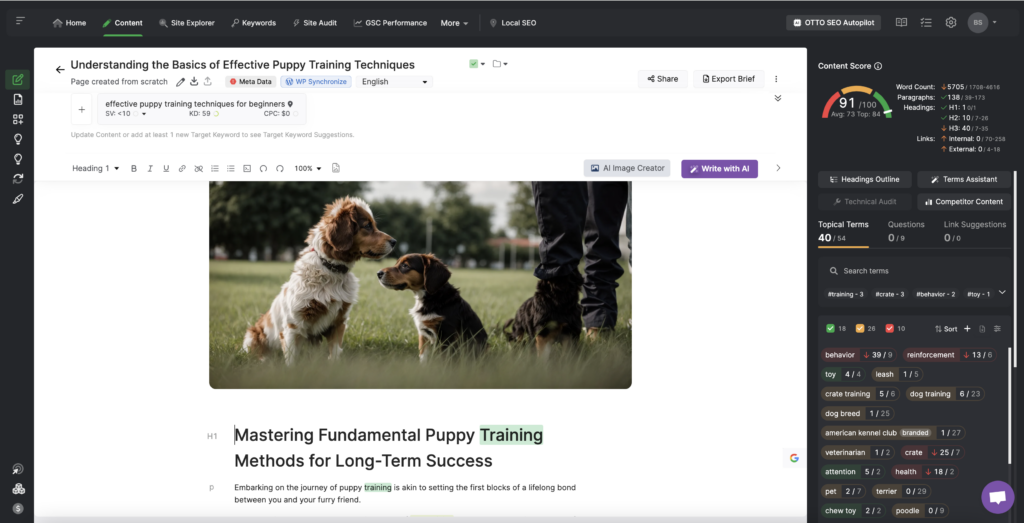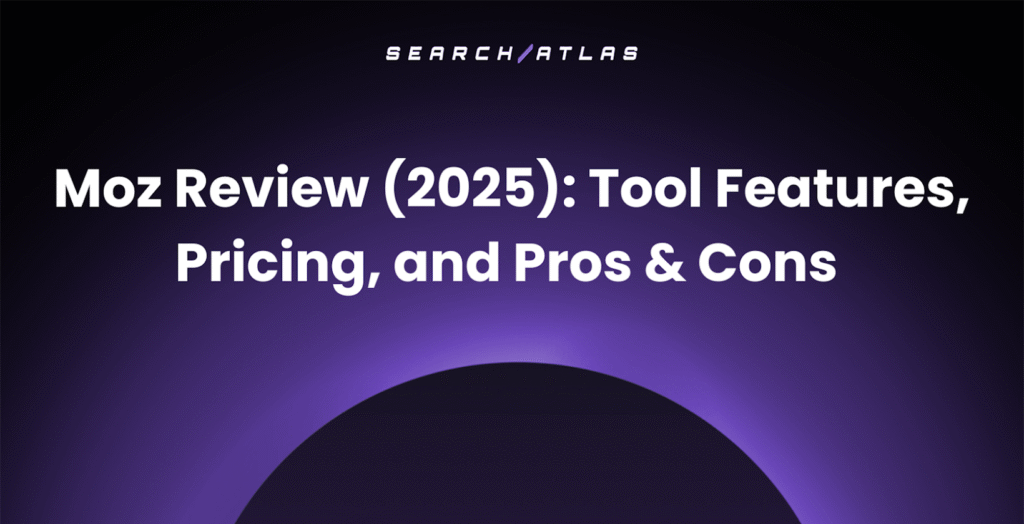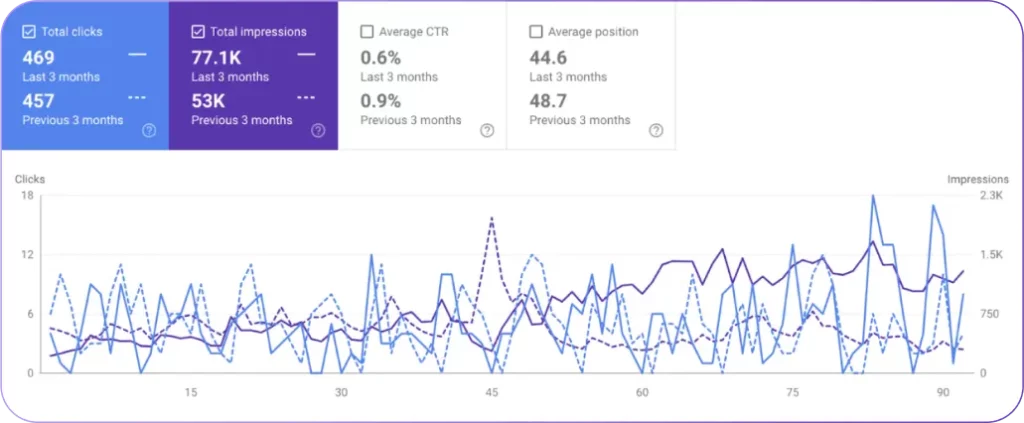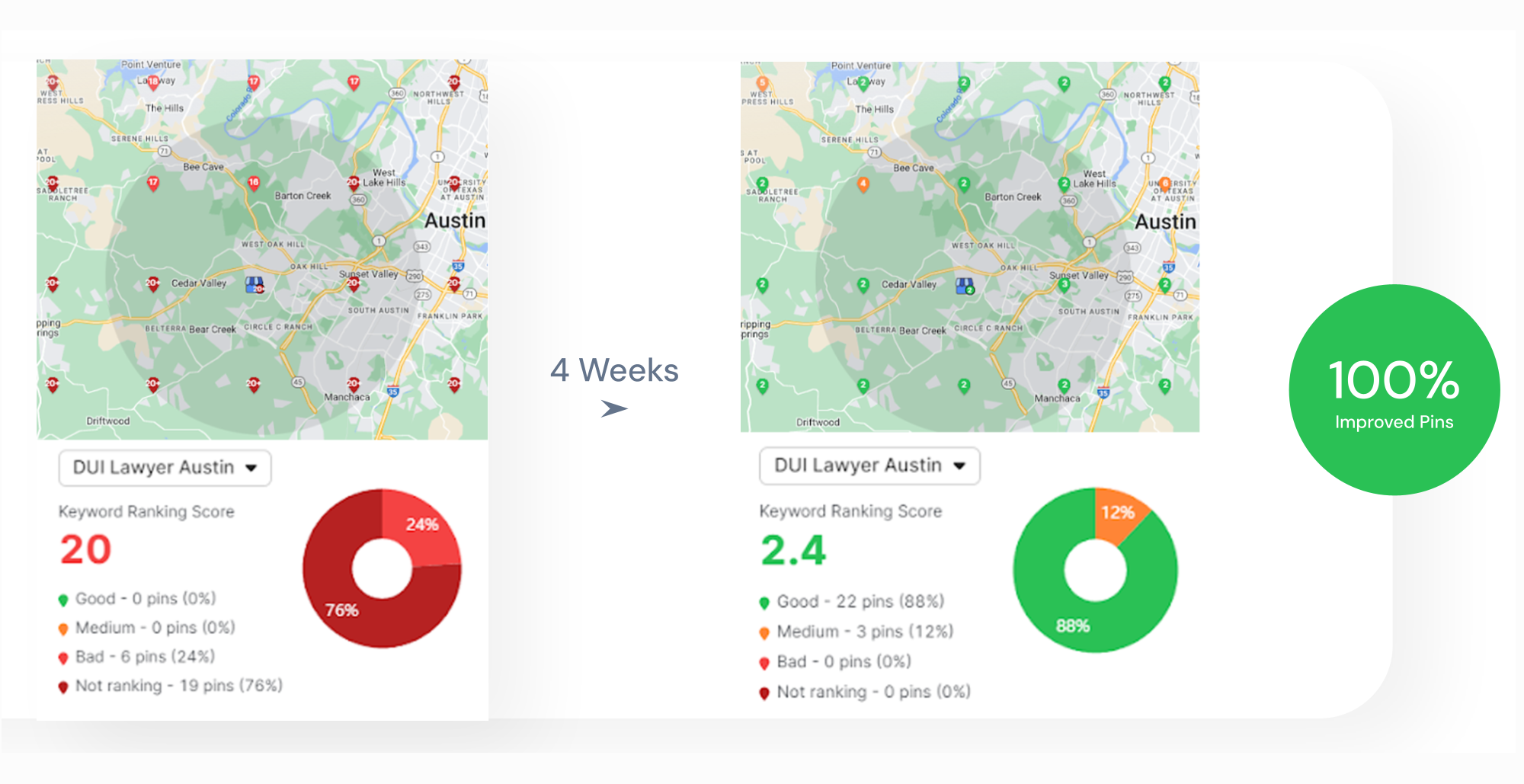We all know that acquiring the right backlinks can make the difference between getting lost in the endless digital crowd or shining in the spotlight of the SERPs.
But how do you know if a website is truly worth getting backlinks from? Metrics like Domain Authority (DA) and Domain Rating (DR) can be gamed, leaving you guessing about a domain’s actual value.
During a casual conversation over beers in Turkey, Manick Bhan, the creator of Search Atlas, and Aleks Ivanowski, Founder of Parasite SEO, started chatting about the frustrating flaws in popular SEO metrics, and the conversation took an interesting turn:
What if we could measure a website’s power the way Google truly does? 🤔
That “aha” moment led to the creation of Domain Power.
In this article, we’ll unpack what Domain Power is, why it leaves traditional metrics in the dust, real-world examples using Site Explorer, and how you can use it to level up your SEO game.
Ready to dive in? Let’s go! 👇
What is Domain Power?
Domain Power (DP) blends organic traffic and ranking keywords to create a reliable indicator of a site’s authority. Unlike traditional metrics that rely heavily on backlinks or external signals, DP uses real-world performance data straight from Google Search Console (GSC).
Its purpose is to give you the most accurate off-page SEO insights to evaluate link-building opportunities and uncover real value.

Why Should You Care About Domain Power?
Many websites earn strong backlink profiles the right way, getting links from high-quality sites with real traffic.
But some use manipulative tactics to artificially boost their authority metrics. That’s a red flag. 🚩
For example, a domain might boast a DA of 80+ but attract virtually no organic traffic, have no keywords ranking, or lack relevance. How do they do it? There are several techniques, including:
- Link Farms: Networks of sites linking to each other to artificially boost backlinks. For instance, unrelated blogs or directories linking to one another.
- Spam Networks: Fake websites created solely to generate backlinks and manipulate rankings. Think automated comment spam on irrelevant blogs.
- Shallow Backlink Profiles: Few, low-quality backlinks lacking diversity and authority.

That’s why so many SEOs are skeptical about authority metrics. And honestly, we get it. We’ve been there too—frustrated by how unreliable they often seem.
That’s exactly why we created Domain Power: This metric can’t be manipulated. But how did we do it?
How Was Domain Power Born?
It all started with a brainstorming session between Manick Bhan and Alex Ivanowski, where they discussed how popular metrics like DA, DR, and TF are just too easy to inflate.
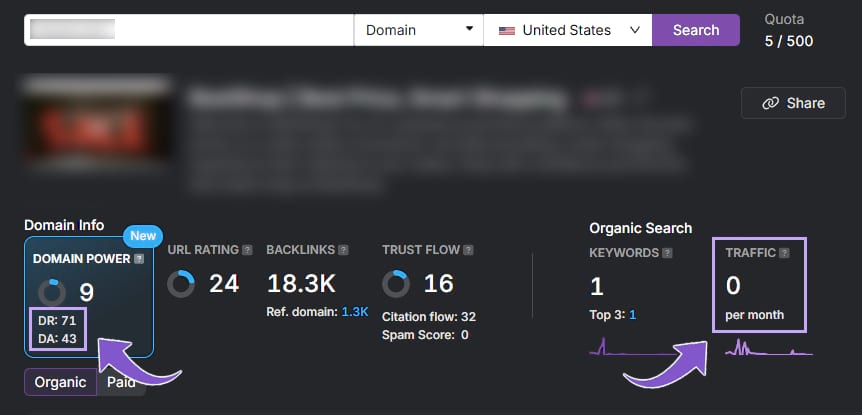
The duo of SEO masterminds has been diving deep into the leaked Google API documentation by Erfan Azimi, and it’s been a wild ride. 🎢
One of the most surprising discoveries? Anchors aren’t actually anchor text, but the backlinks themselves. They also found that Google sorts backlinks into three separate index tiers, based on what we’ve uncovered so far.

There are dozens of authority signals that Google analyzes. After months of deep dives and rigorous testing, Manick cracked the code: Google values relevance and performance over just raw backlink counts when evaluating a domain.
Unlike other metrics, Domain Power was created to mirror how Google truly assesses authority today.
How Domain Power is More Accurate Than Other Metrics
Don’t get us wrong, we appreciate the brands that introduced traditional metrics. They laid the groundwork and gave us a solid starting point. But we’ve taken those ideas and improved on them.
Legacy metrics like DA and DR miss the mark because they’re based on outdated principles. They focus too much on backlinks and fail to adapt to how Google’s algorithm has evolved.
SEO nerds, keep reading for the juicy details. 🤓
How Google Measures the Authority of Websites
Google’s authority evaluation began with the vulnerable PageRank system, which was often exploited. But it’s come a long way, evolving into a much more sophisticated model that considers numerous concepts and signals:
- PageRank: Google initially measured a page’s importance based on the number and quality of links. Links from one page to another increased PageRank, but multiple links from the same page would split that power.
- Reasonable Surfer Model: Google started prioritizing links based on user behavior. Factors like link position, size, and anchor text all began to influence link value.
- Historic Data Patent: This adjustment took the age and history of a page into account, with backlink value decaying over time.
- Nearest Seeds: High-authority “seed” sites pass their power to nearby pages, making their links more valuable. Trust Flow (TF) attempts to measure this proximity but still falls short of fully replicating Google’s algorithm.
- AdSense: Google began using advertising data signals, like AdSense visitor metrics, to assess content quality based on user engagement and traffic patterns.
- Panda Update: This update focused on “reference queries” — searches where users specifically sought out a particular site or page, signaling authority and importance.
- Click Duration: Google now tracks how long users stay on a page after clicking on it to gauge SEO user experience.
Google now rewards branded search traffic and penalizes low-quality content, encouraging sites to focus on trust and authenticity over shady tactics.
What Signals Does Google Measure on Domains?
All of these authority signals are stored in a model called “CompressedQualitySignals” inside Google’s API.
We’re talking about a long list, including site authority, page quality data, Panda demotion, SERP demotion, anchor mismatch removal, topical embedding, scammy signals, and more.
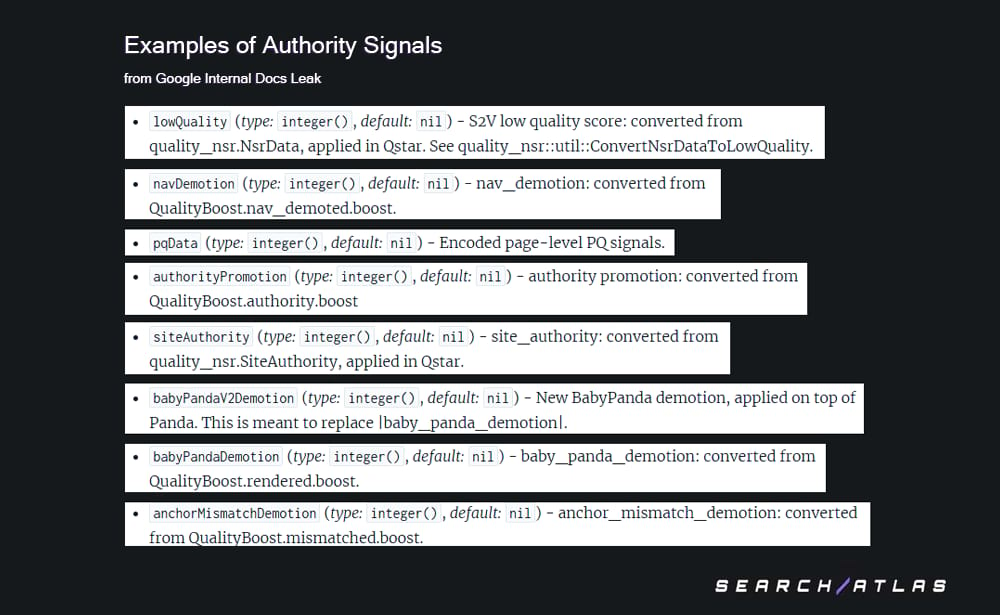
After studying these signals, there’s one key takeaway that blew our minds:
This isn’t just about backlinks anymore. Google has gotten much smarter, and now two key factors really stand out:
- Page Quality: Content needs to be exceptional. If it doesn’t meet high standards, it won’t cut it.
- Topical Dominance: Google wants to know if your site is the authority in its niche. Are you the go-to source for your industry? If yes, you’re in great shape.
Backlinks still matter, but now, quality content and being a true authority in your space make all the difference.
Domain Power takes all these factors into account, making it the most accurate way to measure a website’s ranking potential.
What is a Good Domain Power Score?
Domain Power keeps its scoring fair and grounded in reality. It reflects true authority and can’t be inflated, so you’ll always know which sites are worth your time. Here’s how you can evaluate a website:
- The Titans (65 to 100): Established brands that rank for hundreds of thousands of keywords and drive tons of traffic. E.g., Google (100), Forbes (83), Figma (71), SpaceX (65).
- Niche Leaders (35 to 65): Reputable brands excelling in their industries with strong relevance, traffic, and keywords. E.g., HTC (60), Saucelabs (51), Power (44).
- The Builders (0 to 35): Smaller sites still growing their influence. Top sites here are building authority to gain traction. E.g., Supply Land (34), Winter (28), Labels (14).
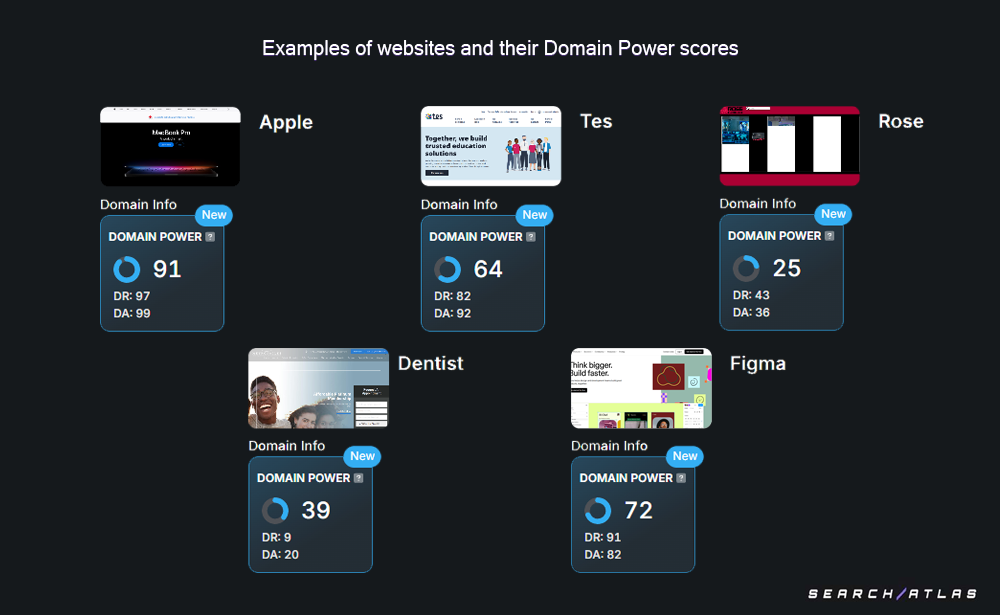
Pro tip: You don’t need to chase just the big players in your industry. Google knows smaller websites with high-quality, focused content can make a big impact, especially in niche markets.
For instance, consider a niche B2B platform for industrial supplies with a Domain Power of 34. It may not have the reach of a site with a Domain Power of 80+, but with great content, solid traffic, and a specialized focus, it can offer a valuable, relevant backlink that boosts your credibility.
Domain Power helps you uncover these hidden gems: Smaller but trustworthy sites that can strengthen your strategy in ways other metrics often miss.
What Are Some Real Use Cases of Domain Power?
Domain Power isn’t just theory; it delivers real results. Let’s dive into some juicy data and use cases to show how it stands out.
Domain Power Correlation Study
We conducted a study analyzing thousands of websites to find out which metrics align best with top-ranking pages.
We looked at organic traffic, organic keywords, keywords in title, backlinks, and even Domain Rating (DR) and Domain Authority (DA).
So, what did we find?
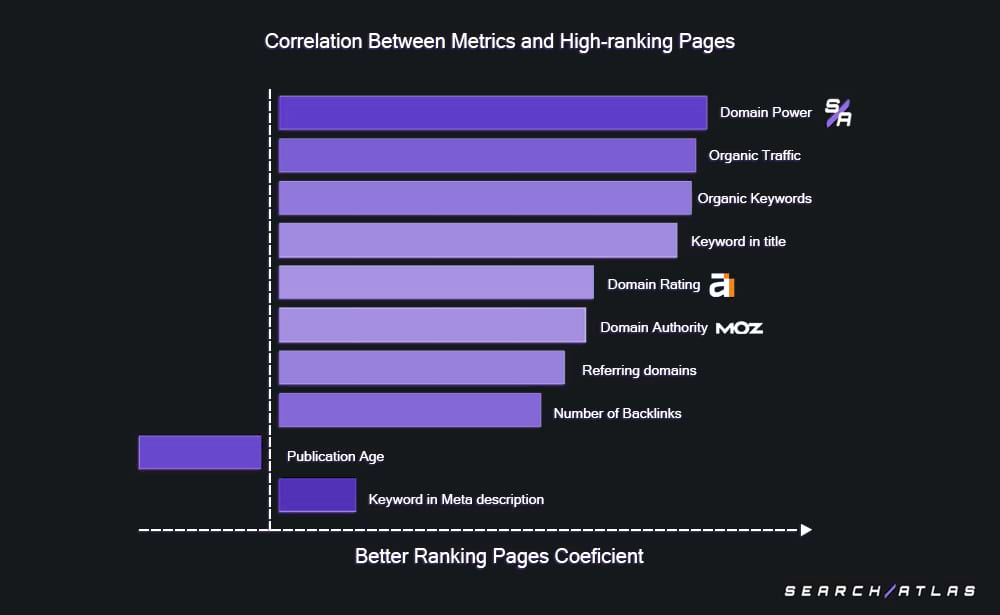
Domain Power significantly outperforms DA and DR, offering a much more accurate reflection of what Google truly values.
Curious about the details? Let’s break it down.
We used Site Explorer to compare these metrics. It’s a handy tool that consolidates authority metrics, backlinks, traffic, and more in one easy-to-read dashboard, making our analysis much simpler.
Domain Power vs. Domain Authority
Take this website with a DA of 48. It ranks for only 2 keywords, drives zero traffic, and relies on 723 backlinks for its score. Even if those backlinks are “relevant,” the site itself isn’t considered relevant by Google.
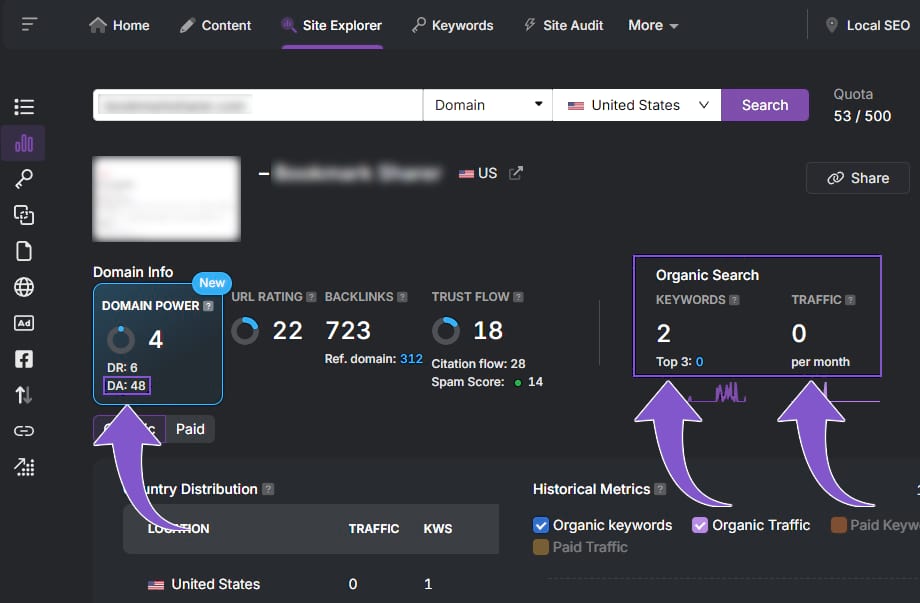
Why acquire backlinks from a source that search engines don’t value? Domain Power flags this with a low score of 4, it’s just not relevant.
Now, look at the second website. It has a DA of 20 but drives decent traffic and ranks for 4.4K keywords.

Clearly, both Google and users value it more than the first example. Domain Power gets it right with a score of 40.
You’ll see a similar issue when comparing Domain Power to Domain Rating (DR).
Domain Power vs Domain Rating
Let’s take a look at this example: We’ve got a website with a DR of 71 and over 10k backlinks. But it ranks for just one organic keyword and gets only 27 visitors.
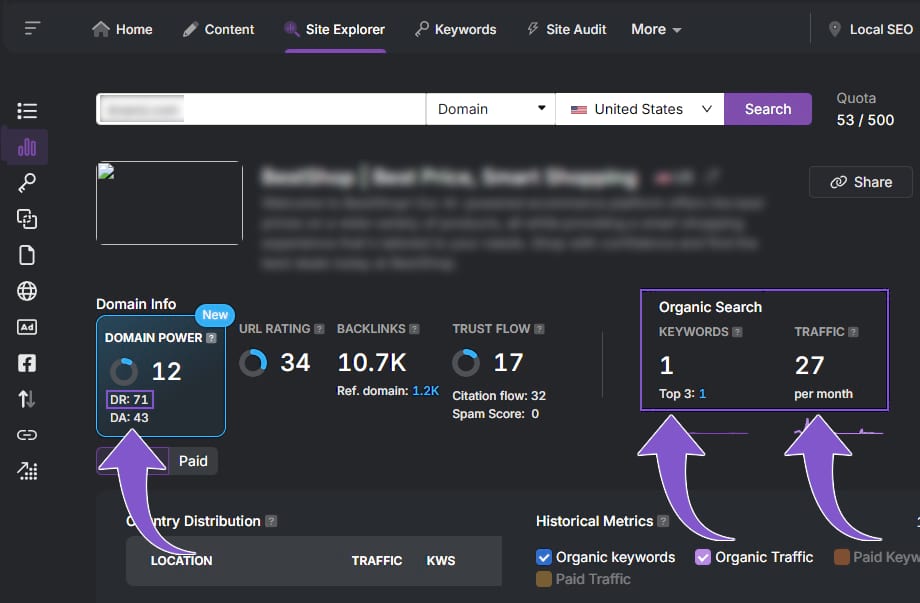
Even though DR treats it as a high-value, trustworthy site, Google clearly doesn’t agree. Domain Power gives it a fair, low score of 12, reflecting its lack of actual value in search results.
Now, let’s flip it. We have another website with a DR of just 13. Yet, it ranks for 5.8k organic keywords, with 285 of them in the top 3. It’s driving 6.3k visitors a month.
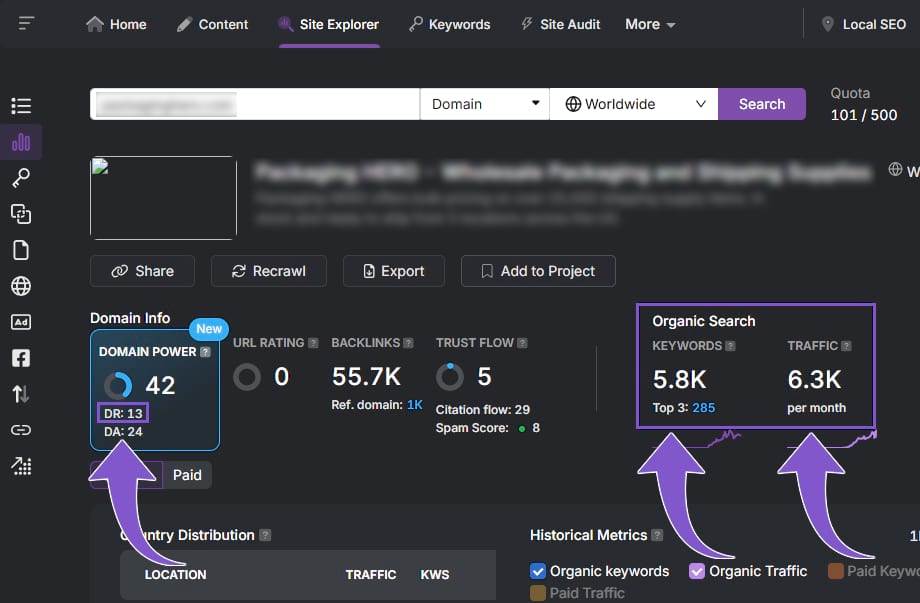
Google sees this site as far more relevant, rewarding it with traffic, and Domain Power gives it the higher score of 42 it deserves.
This is another example of how Domain Power is more accurate than DR and DA. But what about Trust Flow (TF)?
Domain Power vs. Trust Flow
TF can be a bit hit or miss, and sometimes it feels downright unfair.
Take this example: One website has a TF score of 31, ranks for 2.4k organic keywords, and gets 1.7k monthly visitors.

Domain Power gives it a similar score of 35. Seems fair, right?
Now, let’s look at another site: it ranks for 4.4k organic keywords and gets even more traffic, 1.9k per month. But here’s the kicker: its TF score is zero.

Feels pretty unfair, doesn’t it? Here’s where Domain Power steps in, giving this site a much more reasonable score of 40, reflecting its real value and relevance.
These examples highlight just how much more reliable Domain Power is when it comes to shaping a smarter, more cost-effective SEO link-building strategy.
How to Use Domain Power in Search Atlas
As you saw with the use cases, you can easily check the Domain Power of any website or page using Site Explorer.
But here’s the cool part: you don’t have to analyze each site individually. With the bulk URL analyzer, you can assess up to 5,000 websites at once. Yep, 5,000! 🤯

This is an absolute game-changer for large-scale SEO campaigns.
Domain Power will also be integrated into SearchAtlas SEO‘s Chrome Extension for even quicker insights into the authority of ranking pages.
What Does the Future Hold for Domain Power?
We’ve all been there: Checking a website’s authority and wondering if it’s really relevant to your niche. Or maybe acquiring backlinks from sites that turned out to be less relevant than you thought.
With Domain Power, that’s a thing of the past. You can now analyze a site’s authority the way Google sees it, helping you build a strong, relevant backlink profile and achieve top spots in the SERPs. 🏆
Domain Power isn’t just another metric; it’s reshaping how we approach link-building and site authority by giving you a reliable way to drive real results.
Got a list of websites you want to check for Domain Power? Start analyzing them right away by signing up for a free trial!


